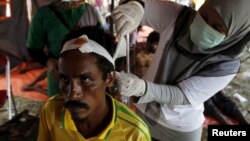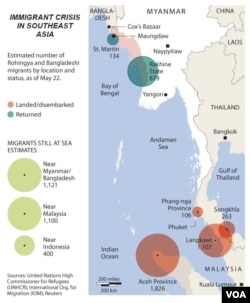Of the roughly 3,000 boat people who have landed in Thailand, Indonesia and Malaysia in recent weeks, about half are ethnic Rohingya who are fleeing persecution in Myanmar. The rest are mainly Bangladeshi men whose quest to provide for their families has led them to embark on the dangerous sea journey.
“A huge number of men from Bangladesh are taking the boats with a hope to reach Malaysia for jobs there. In our boat the Bangladeshis outnumbered the people from Myanmar. Among 160 or 170 people there were 116 Bangladeshi men,” said 22-year-old Bangladeshi youth Ibrahim Hossain, who spent more than a month on a human smuggler’s boat.
Hossain and others on that boat were rescued by the Bangladesh Coast Guard in the Bay of Bengal last week after it was deserted by its crew, perhaps because of the crackdown on the human trafficking networks in Thailand.
“I heard from different sources how many people landed good jobs in Malaysia after reaching there by trawlers. So, with a hope to get a job in Malaysia I too attempted to reach there the same way,” Hossain told VOA.
Although the boat that Hossain boarded did not make it to Thailand, many other Bangladeshi men have managed to reach the shores of Southeast Asian countries in recent days.
Last week, after three boatloads of people quietly landed on the Malaysian island of Langkawi, the authorities found that among 1,018 boatpeople, 463 were ethnic Rohingya men, women and children from Myanmar, and 555 were men from Bangladesh.
Earlier this month, the International Organization for Migration (IOM) estimated about 8,000 people from Myanmar and Bangladesh were still adrift in the Bay of Bengal and Andaman Sea.
Many more Bangladeshis now risking sea journeys
Jeffrey Labovitz, Chief of Mission of the IOM in Thailand said that the number of Malaysia-bound Bangladeshi migrants on smugglers’ boats has soared in the past two years.
“If you go back three years ago or five years ago, there were 2,000 or 3,000 people departing a year on these boats. Over the past 6 or 8 months they have been leaving at the rate of 7,000 to 8,000 per month. So, there has been a dramatic increase in number of particularly the Bangladeshis over the past two years,” Labovitz said.
Malaysia has long been a destination for poor Muslim migrant workers. Myanmar’s ethnic Rohingya began illegally entering Malaysia in search of work in the early 1990s.
Bangladesh police said they noticed that Bangladeshi men began joining the Rohingya on the boats about six or seven years ago.
“Following the Rohingyas, a few Bangladeshis began taking the boats around 2008 or 2009. Our inquiry found that it was in 2012 that Bangladeshi men from different districts leaving for Malaysia on this illegal route in good numbers,” Tofail Ahmed, additional superintendent of police of Cox’s Bazar district, told VOA.
About one quarter of Bangladesh’s 160 million people live below the poverty line. Recurring natural disasters like floods and cyclones have made life increasingly difficult for many, leading large numbers to go abroad in search of better opportunities.
Dwindling options for Bangladeshi migrant workers
Countries like Saudi Arabia, United Arab Emirates, Kuwait, Oman, Jordan, Singapore and Malaysia have traditionally been the destination for most Bangladeshi migrant laborers. However, for different reasons, most of these countries began cutting down labor imports from Bangladesh in recent years.
In 2008, according to a government figure, more than 870,000 Bangladeshis worked abroad - most of them in the Gulf countries. But in 2014, the figure fell to about 425,000.
Following a break of six years, in 2013, Malaysia resumed hiring laborers from Bangladesh. However, the process of exporting labor to Malaysia has been very slow- with only about 7,000 Bangladeshi workers gaining entry in the past two years.
As workers lose hope of finding jobs through legal migration, desperate Bangladeshi men are seeking entry into Malaysia illegally through smugglers’ boats.
People smugglers traditionally carried the Rohingyas and then the Bangladeshis by sea to Thailand, then overland to Malaysia. But after Thailand began cracking down on the migrant route recently, the traffickers are using the sea routes in attempt to take the people to Malaysia.
The illegal migrant route to Thailand and Malaysia has all along been fraught with high risks. The U.N. refugee agency UNHCR said 540 Malaysia-bound boatpeople died last year in the Bay of Bengal because of starvation, dehydration, disease and torture by the boat crews and people smugglers.
About 300 people from Bangladesh and Myanmar died at sea in the first quarter of this year, survivors told the U.N. After the recent discovery of dozens of bodies in mass graves in southern Thailand, it became clear that migrants from Bangladesh and Myanmar also died overland, in the custody of the human smugglers.
Many choose to make the journey, despite the risks
Mohammed Shahiduzzaman, a former Bangladesh Nationalist Party member of parliament said that the desperation of those trying to find work abroad has lengthened the sailing season for the Malaysia-bound boats, making the journey even more dangerous.
“Until 1 or 2 years ago, boats carrying Malaysia-bound people used to depart from Bangladesh usually only during winter- between November and January, when the sea is calm. But now the illegal boats are running throughout the year with increasing number of Bangladeshis seeking to reach Malaysia,” Shahiduzzaman said.
Abdul Hakim, a rickshaw-puller in Khutakhali village of Cox’s Bazar said that he is planning to leave for Malaysia next winter.
“I cannot manage my family with my meager income in Bangladesh. The employment situation is very grim here. Some people I know are working in Malaysia well and they are sending good amount of money back home. So, I have decided to take a boat for Malaysia,” Hakim said.
He added that he was aware of the dangers found along the illegal route to Malaysia, and is planning to go anyway.
“So many people have changed their fortune by taking such risks,” he said. “Life is full of risks. I am happy to take risk on way to Malaysia.”








